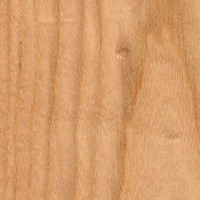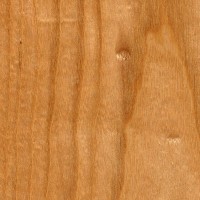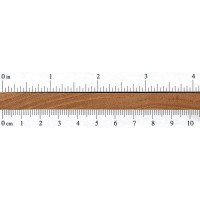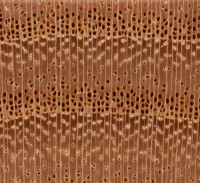 |
Common Name(s): Kentucky Coffeetree, Coffeetree Scientific Name: Gymnocladus spp., Gymnocladus dioicus Distribution: Eastern North America Tree Size: 65-100 ft (20-30 m) tall, 2-3 ft (.6-1 m) trunk diameter Average Dried Weight: 42 lbs/ft3 (675 kg/m3) Specific Gravity (Basic, 12% MC): .53, .67 Janka Hardness: 1,390 lbf (6,180 N) Modulus of Rupture: 10,500 lbf/in2 (72.4 MPa) Elastic Modulus: 1,420,000 lbf/in2 (9.79 GPa) Crushing Strength: 6,600 lbf/in2 (45.5 MPa) Shrinkage: Radial: 4.1%, Tangential: 7.6%, Volumetric: 11.9%, T/R Ratio: 1.9 |
Color/Appearance: Heartwood an orange to reddish brown. Yellowish white sapwood is very narrow and well defined against heartwood. Overall appearance and grain pattern similar to ash or oak.
Grain/Texture: Grain is straight and porous, with a coarse, uneven texture.
Endgrain: Ring-porous; 2-4 rows of large earlywood pores, numerous medium to small latewood pores, sometimes clustered, in wavy or tangential arrangement; tyloses absent; growth rings distinct; rays fine and not visible without lens; parenchyma vasicentric, and sometimes aliform (winged and lozenge), confluent, and banded, especially in latewood zones.
Rot Resistance: Reports range from moderately durable to very durable regarding decay resistance, and is reported to fare well in direct ground contact. Reports are mixed on resistance to insect attack.
Workability: Coffeetree has good working characteristics, and nearly every machining operation can be done with good and expected results. Glues, stains, and finishes well.
Odor: No characteristic odor.
Allergies/Toxicity: Besides the standard health risks associated with any type of wood dust, no further health reactions have been associated with Coffeetree. See the articles Wood Allergies and Toxicity and Wood Dust Safety for more information.
Pricing/Availability: Coffeetree is not a common tree, and though it grows on a number of sites in the United States, it is not plentiful in any one location. Supplies for Coffeetree lumber are likely to be limited, and mostly available only within its natural range in the Midwest and eastern United States. Prices should be in the mid to upper range for a domestic hardwood.
Sustainability: This wood species is not listed in the CITES Appendices or on the IUCN Red List of Threatened Species.
Common Uses: Furniture, cabinetry, fence posts, and utility wood.
Comments: So named because early settlers (particularly in the state of Kentucky) used roasted seeds from this tree to make a coffee substitute. Today, no such use is made of the tree’s seeds, but the wood is sometimes harvested and used for a variety of general construction purposes.
Along with Black Locust and Honey Locust, Coffeetree is one of the most fluorescent woods when viewed under a blacklight, glowing a bright yellowish green.
None available.








Desk I made a few years ago. Here in Indiana kiln dried coffeetree is relatively inexpensive. No bad smell.
I’d like to see any projects you may have made with this wood, before today I didn’t even know it existed.
I don’t find it often from suppliers, but when I do, I snatch up what I can afford. It turns well and has great tonal qualities when used in a turkey call. The piece used for the striker in the picture has much darker contrasting grain, and was the only board I have found in over a decade with such dark coloration.
That turkey call looks extremely well made.
I wasn’t expecting that level example. How do you use that to create the sound? There are no turkeys where I live which is high plains desert.
Sort of looks like oak btu somehow more refined.
Reading all the comments about how the wood smells, I’m thinking one of two things is happening: A threshold of moisture-content has to be passed in order to eliminate the smell: are some people working with fresher or moister wood, while other people have kiln-dried or well-aged wood? Genetics. This is why I’m making this comment at all. Some people can taste phenopthaline, some can’t, and it’s so completely true that it’s used as an example in genetics classes. Is it possible that some people have a gene that allows them to detect the “vomit” smell in Kentucky coffeetree sap,… Read more »
I think you’ve hit the proverbial bullseye here. It’s well-known that there are individual differences not only in the substances that are smelled and/or tasted, but also the intensity. So it’s not only sensible, but actually expected and predictable, that different people would react differently to the perceived smell of this wood, and *all* woods. It would be interesting, though, if your idea was pursued, because it might be useful to know whether the ability (or lack thereof) to sense various airborne substances, and the strength with which they’re perceived, might be related to various potentially-important aspects of individual physiology.… Read more »
FYI if anyone wants to grow this tree: Some people have the idea the seeds are difficult to sprout. No: it’s only a timing issue. People tend to harvest seeds when pulp and seed-coat are fully dry, and seed coats have become impervious to water unless manually scored. Instead, harvest seed pods from the tree in February or early March, when the pulp hasn’t yet dried out. Shell and wash the seeds, remove all those with a flattened or irregular shape. Soak overnight. Viable seeds will swell noticeably. Remove the largest swollen seeds for sprouting; change water and continue soaking… Read more »
Actually when you turn wood that is not fully seasoned it smells strongly of bad milk or vomit.
I have some coffeetree on my property, and cut quite a bit for fence posts along with some black locust. I did experience the foul smell, but it seemed to be coming from the inner bark which by the time I was peeling the logs seemed to have “gone sour” and even had a mucus like consistency. The wood itself did not seem to have that same odor. These were all trees in the 6-8″ diameter range.
I’ve made 5 occasional tables from a tree I milled and planed myself. No odor.
What’s an occasional table ? The kind the have a hinged top?
No, they are usually small tables used for a variety of purposes, such as end tables. They are usually shorter than a dining table.
What stain choice and color shade would you recommend for coffee wood
I am a wood carver this wood is excellent for carving.No bad smell at all. People just trying to drive prices up.
Also good for wood turning. I’ve used it in several segmented bowls. Most recently in combination with purple heart Great contracting pairing.
Dear Ken, I have some wood pieces with your name on the bottom of them one was dated August 2011.. Please message me back. I would like to know what these were used for candlesticks?
I had the same experience with coffeetree odor, had to take it out of the house. Exactly, like vomit or spoiled milk.
I’m a professor and I too smelled vomit. I did I really did. I frequent comment sections and forum to spin people away form natural solid woods in hopes to profit off the junk sustainable laminate wood. Shush it’s a secret though.
There are plenty of sustainable harvesting woods
I think the problem lies in getting people to plant the seeds to replace what the cut. If everyone did that we’d only be one generation behind every harvest
Why would you need to plant seeds/seedlings with sustainable forestry especially for hardwoods?
I recently milled some Kentucky Coffee Tree, and I have to say it has one of the worst odors I’ve encountered, even worse than Pin Oak. The smell is similar to either vomit or spoiled milk.
I didn’t notice any unpleasant smell when I made my table. It had a pleasant, but generic “wood” smell. It worked well, although it did burn a bit before I changed to a fresh blade
I have a “bunch” of this stuff and I find that it burns pretty badly (I know, how can it be “pretty” and “bad” at the same time and no, I am not an English teacher. ) Router bits tend to be the biggest culprit much like Cherry. Any solutions?
That wasn’t a coffee tree smelling. You made an id error or stepped in something.
Ky Coffee does not smell. I have 1000 bd ft. Have built several pieces of furniture using coffee tree. Including a king size bed. It has no offensive odor.
Fresh cut oak smells like vomit also. Obviously, if you let it dry, the odor goes away, since oak lumber does not have such an odor.
depends…the white oaks produce lumber that smells like booze….